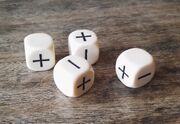
Four white Fudge Dice
A dF is a die with an equal chance of rolling the numbers +1 (usually represented by a plus, [+]), 0 (usually represented by a blank face, [ ]), and -1 (usually represented by a minus [‑]). They are most commonly rolled in dice pools of four, written 4dF.
Because the results are evenly distributed around 0, the results of any size of dice pool containing only dFs will also be evenly distributed around 0. The larger the dice pool, the closer it will tend to a normal distribution.
Forms[]
There are three common forms of the dF (although the first two are significantly more common than the third), which are:
- Fudge Dice: Six-sided dice (similar to d6) but with two faces each of [+], [ ], and [‑]. The identical faces are on opposite sides.
- Fate Dice: Like Fudge Dice, Fate Dice are six-sided with two faces of each symbol, but the identical faces are on adjacent sides instead of opposite ones. Fate Dice are a trademark of Evil Hat Productions (the publishers of Fate Core), and are sold by them as high-quality products, usually in packs of 12 (3 sets of 4dF).[1]
- DoubleFudge Dice: Twelve-sided dice (similar to d12) with four faces of each symbol. Each symbol is both adjacent to one identical symbol and opposite another one. DoubleFudge Dice are produced by the company DoubleSix Dice,[2] having been added to their successful Generation Two Kickstarter.[3]
Uses[]
dFs are almost exclusively used in Fudge and games derived from it, such as Fate (including Fate Core). These games use a dice pool of 4dF (four dF dice rolled at the same time and then added together, per standard dice notation) for all of their resolution mechanics. A modifier is usually added based on an appropriate statistic or statistics (e.g. skills in Fate Core, approaches in Fate Accelerated Addition), and then either compared to an opponent's roll or a fixed target number.
Special random tables also exist for use with dFs, as used for example in Masters of Umdaar, a Fate World of Adventure (campaign setting published by Evil Hat). dF random tables are triangular, and the appropriate cell is determined by starting in the top left corner then moving one cell to the right for each '+' in the 4dF result, then moving one cell down for each '-' in the 4dF result, while discarded blank face results without moving. This means that each result in the table is not equally likely, and it is only possible to get the corner cells by rolling 0000 (for the top left), ++++ (for the top right) or ---- (for the bottom left), which are the least likely rolls on 4dF. Any other combinations will produce a cell in the table's interior; the closer to the middle of the table, the more likely it is to be selected.
Alternatives to 4dF[]
Several attempts have been made to replicate (or approximate) the results of dF rolls with other means. Most notably, the same dice roll can be achieved with normal d6s, treating each 1 or 2 as [‑], each 3-4 as [ ] and each 5-6 as [+] (or some equivalent). 4dF can also be simulated by most RPG electronic dice rollers, and some dice rollers exist that are exclusively designed for dFs.
However, other methods of simulating a 4dF include:
- Randomly draw four Fate Tokens from a bag of twelve. Each token is marked with either a [+], [ ], or [‑]. This produces a similar probability distribution, with slightly higher chance of middle results and lower chance of results that are either very high or very low.[4]
- Randomly draw one of the 81 Dice Cards from the Deck of Fate, which matches the odds of a 4dF roll when the deck is complete and shuffled.[5]
- Instead of rolling 4dF, a similar probability can be obtained by taking d6‑d6, although the range of results is wider (-5 to +5 instead of -4 to +4) and the curve is flatter (i.e. middle results are less likely).
References[]
- ↑ "Fate Dice". Evil Hat Productions. Retrieved 2020-07-24.
- ↑ "DoubleFudge Dice". DoubleSix Dice. Retrieved 2020-07-24.
- ↑ "DoubleSix Dice: Generation Two by Matt Fleming". Kickstarter. Retrieved 2020-07-24.
- ↑ Paul Stefko (2014-07-25). "Fate Tokens of Kickstarter". One Yard Hex. Retrieved 2020-07-24.
- ↑ "Deck of Fate". Evil Hat Productions. Retrieved 2020-07-24.
External links[]
- Fate Dice Statistics by Alex Gude
